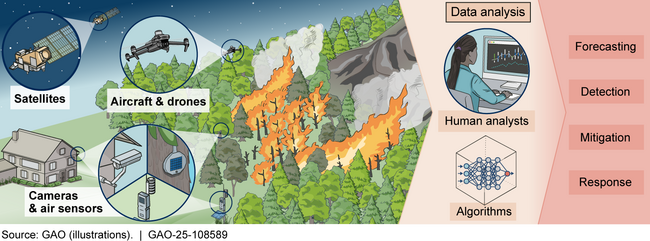Wildfire Management: Technologies for Forecasting, Detection, Mitigation, and Response
Fast Facts
We testified on wildfire management technologies before the House Committee on Natural Resources, Subcommittee on Federal Lands.
It is based primarily on the following reports:
Science & Tech Spotlight: Wildfire Detection Technologies
Artificial Intelligence in Natural Hazard Modeling: Severe Storms, Hurricanes, Floods, and Wildfires
We've made recommendations and offered policy options related to these issues. Agencies have addressed some of our recommendations but still need to address others.

Highlights
What GAO Found
Some key technologies currently used in wildfire management include:
- Satellites, which provide data that are integrated into models for wildfire forecasting, including data on terrain, vegetation, and weather. They are also used for detection and monitoring, although some satellites face resolution issues, data lags, and other limitations.
- Aircraft and drones, which can deploy to the scene to collect information on a fire’s location and its potential to spread. Aircraft and drones with thermal cameras can see through smoke and dense trees, helping to locate fires and determine their intensity. Challenges include safety issues for aircraft pilots and limited drone lifespan (3 to 5 years, or less in harsh conditions).
- Cameras and air sensors, which are used in several states for wildfire detection, sometimes in extensive networked systems. For example, in 2024, Hawaiian Electric stated that it began deploying high-resolution cameras with artificial intelligence (AI) for early fire detection. For both cameras and sensors, installation, data transmission, and fire verification may be challenging in remote areas. Sensors may require dense networks to operate accurately.

AI tools have the potential to improve modeling for wildfire forecasting and response. AI may help address key limitations of the traditional mathematical models used for wildfire. For example, AI can:
- Allow models to use more data by speeding up data assimilation, the process of updating forecasts with the most current observations.
- Rapidly flag potential inaccuracies for human review.
- Potentially reduce uncertainty in some situations when data do not exist or are insufficient, by using prior information to create plausible synthetic data.
However, use of AI in this field faces challenges. For example, AI requires extensive up-front work to ensure the data are readily usable by AI tools, which can be costly. AI also presents a risk of conveying inaccurate information, which can put lives and property at risk. In addition, historical data are limited for rare events, which may limit the utility of AI for forecasting extreme wildfires.
Why GAO Did This Study
Annually, wildfires in the U.S. cause an average of 12 deaths and cost at least $3.2 billion. Wildfire severity has increased across much of the country, a trend that is expected to continue. Current and emerging technologies have the potential to save lives and property by improving forecasting, detection, mitigation, and response.
This testimony provides information on selected technologies and on the benefits and limitations of AI tools to enhance use of these technologies. This statement is based on prior GAO work, including a 2023 report on the use of AI to model wildfires and other natural hazards; a 2025 report on wildfire detection technologies such as satellites, aircraft, drones, cameras, and sensors; and prior GAO reports on forest management, wildfire staffing, and interagency coordination on wildfire response.
Recommendations
In prior work, GAO has provided policy questions and options, which policymakers could consider to improve adoption of wildfire technologies and the use of data. Policy options include: expanding the use of existing observational data and infrastructure to close data gaps, establishing guidelines for making data readily usable by AI, updating education requirements to include coursework related to machine learning (ML), considering what combination of detection technologies would be most cost-effective, and considering how the costs of technologies could be balanced with other fire management actions.
